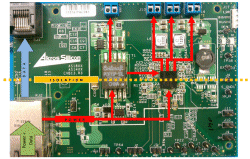The Akros AS1854 power SoC is a game changer for PoE-powered devices. This Product of the Year winner is the first to have a 2-kV isolation barrier and integrate the functionality of numerous ICs and passive components into a single package. As with all cutting-edge technology it didn’t come to fruition without difficulties.
The major challenge at the outset was designing the high-voltage isolation integrated with a power SoC. The requirement was to create a physical isolation barrier that can withstand 4-kVrms separation and 25-kV/µs transients without disrupting high-speed data transfer between the two sides of the IC. These are extremely difficult specifications to follow for any material, let alone implementing them in a bulk CMOS process. The 15-member design team even had to develop unique ways to physically model in 3-D the material and packaging to ensure the chip could withstand the high voltages and transients. And all of this was done on a shoe-string startup budget in just two years.

The AS1854 integrates high-voltage isolation and quad-output digital power dc/dc converters in a single device with minimal external components and no optocouplers
The idea and necessity for the design the company calls the GreenEdge technology came while working with customers who were creating power-system designs for various IP-connected equipment. These OEMs had sophisticated methods to monitor and control logic circuits from remote management software, but were challenged with lack of management and control available in power sub-systems. The Akros team worked with OEMs to understand the pain points involved and trade-offs needed.
GreenEdge technology was the result and helped eliminate the traditional information and communication barrier that existed between high-voltage power domains and low-voltage software domains. It bridges the gap between real-time decision-making software (local or remote) and the power subsystem; providing a superior end-to-end energy management architecture. The isolation technology enables complete remote monitoring and control of IP appliance power subsystems, making network-based energy management a practical reality. It reduces space by 40%, system BoM cost by 25%, and provides efficiencies exceeding 90%. Currently, no other digital isolation technology exists in the industry that is specifically targeted and used for power-system cost and efficiency optimization, or designed to enable network-based energy management.
Paul O’Shea
Advertisement
Learn more about Akros Silicon





